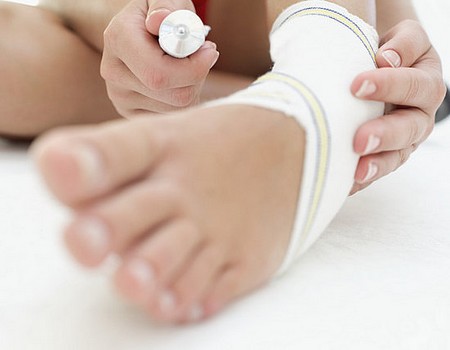The following discussion covers treatments for common musculoskeletal injuries associated with walking and jogging. It begins with the standard RICES treatment.
General Treatment: The RICES Principle
The standard treatment for exercise-related musculoskeletal injuries follows the RICES principle:
R = rest
I = ice
C = compression
E = elevation
S = stabilization
The RICES techniques are designed to control the extent of tissue damage and edema (fluid accumulation).
Rest
The severity of an injury dictates the amount and type of rest required. Complete rest may take the form of immobilization. Active rest may rely on the use of assistive devices such as crutches, canes, and walkers. In any event, the purpose of rest is to allow time for healing without causing additional tissue damage.
Ice
Cryotherapy (the application of cold treatment) is the initial line of defense for acute injuries. The purposes of cold therapy are to decrease pain and to promote constriction of blood vessels at the site of injury, thereby controlling hemorrhage, edema, and swelling. Cold applications are thought to reduce pain either by slowing the speed of neural impulses or by overwhelming the pain receptors with so many cold impulses that the pain impulses are lost.
Compression
Compression (pressure) has a twofold purpose:
1. It controls the accumulation of fluid around the site of the injury by reducing the amount of space available for swelling.
2. The compression wrap decreases extraneous and unwanted movement by the injured body part.
The compression wrap should be left in place for about 72 hours. It should not be worn during sleep and should be loosened if the injured area begins to throb or change color.
Elevation
Elevating the injured part limits swelling by decreasing the pooling of blood that otherwise would occur from the force of gravity. The veins drain blood and other fluids away from the injured area, and elevating the body part facilitates the process. The injured part should be kept elevated for most of the first 72 hours after the injury, including the sleeping hours.
Stabilization
Immediate stabilization of the injured body part through bracing and splinting supports the injured area and allows the surrounding muscles to relax. This decreases the likelihood of incurring spasms in adjacent muscles and reduces pain.
